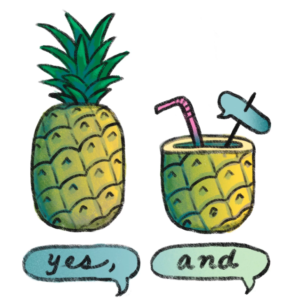NPR published “The rules of improv can make you funnier. They can also make you more confident.” On November 29, 2022. The digital story was edited by Malaka Gharib with art direction by Beck Harlan. I wanted to cement it into the brains of my visitors, so here it is in it’s entirety.
When I moved to New York a couple of years ago, I threw myself into all the activities one typically does when they move to the city. I saw shows on Broadway, picnicked in Prospect Park and became a regular at my bodega.
I also started to take improv classes, which seemed like one of those New York things to do. For three hours every week, I learned the art of performing comedy without a script. And I found that the classes were helping to combat my anxiety and my tendency to overthink — not just onstage, but in daily life. I used to be shy about speaking up at meetings, for example, but after doing sketches in front of a live audience, it seemed like a piece of cake.
It turns out there are several mental health benefits of performing this art. According to a 2020 study published in the journal Thinking Skills and Creativity, researchers found that doing just 20 minutes of improv can increase creativity, well-being and our ability to tolerate uncertainty. Another study from 2019 found that doing improv was associated with reductions in social anxiety in adolescents.
Even if you’re not taking classes, you can still learn a lot from improv’s core tenets, says Clay Drinko, author of Play Your Way Sane: 120 Improv-Inspired Exercises to Help You Calm Down, Stop Spiraling and Embrace Uncertainty. Improv is governed by a set of loose rules that help acting partners work together to perform scenes. And within these principles, he adds, we can practice self-love, build confidence and achieve self-actualization.
Drinko, along with my improv instructor Lou Gonzalez of Squirrel Comedy Theater and Qurratulain “Q” Sajid, a social worker who has taken classes at Untold Improv in San Francisco, share five rules from improv that can be applied to everyday life.
Rule 1: Yes, and

How it’s used in improv: Many improv performances begin with a single suggestion from an audience. Let’s say someone shouts out “pineapple.” The performers will riff on this word to generate ideas for the scene. If you’re on stage and your partner says, “Congrats on opening this tiki bar,” you don’t want to say, “We’re not in a tiki bar, we’re at my pet shop.” That would put your partner in a tough position and make it hard for them to continue the scene. Instead, embody an attitude of “Yes, and,” says Drinko. That helps set your improv partners up for success and builds a shared reality for the performers.
How you can use this rule in everyday life: In life, we have a tendency to say no, says Drinko. It’s easier than trying to listen and understand what someone else is asking of us. For example, we often say no to new ideas because we are afraid of uncertainty. But the idea of “yes and,” he says, gives us a moment to pause, listen and create something new from what someone else is offering.
Rule 2: Embrace mistakes

How it’s used in improv: If you do something you didn’t mean to do in your scene — for example, you mispronounced a word (I once called broccoli rabe “broccoli rah-bay” in class and my scene partners gave me the wildest looks) — you can’t stop, pause and do a retake or get out of character, says Gonzalez. You have to find some humor in the situation and continue on. Instead of getting flustered, I made the mispronunciation part of my character’s personality quirks.
How you can use this rule in everyday life:: “Mistakes can really overwhelm us with a sense of shame and embarrassment,” says Drinko. But if we embrace them and realize that everyone makes mistakes, we’re less likely to dwell on them or let them trip us up. Ask yourself, he adds: was this mistake really the end of the world? “Just like in improv and in everyday life, it’s usually not.”
Rule 3: Don’t shy away from yourself

How it’s used in improv: Some performers think they have to make broad references to pop culture or what’s happening in the news because they worry the jokes won’t resonate with the audience otherwise. But that’s not the case, says Gonzalez. Trust that people will connect with the specifics of your identity, upbringing and perspective on life.
“The more powerful way of getting people to laugh is by being truthful — and that requires vulnerability,” she adds. There’s power in embracing your comedic point of view.
Sajid shares an example of how she’s used her identity as a South Asian in improv. If she has to play an older person, she will never act feeble, frail or forgetful, she says. In her culture, elders are revered — so she plays them with dignity and respect, often highlighting the wisdom they hold in her community. That angle lands with the audience too.
How you can use this rule in everyday life: Just as being yourself can add value to your performance in improv, it can add value to other parts of your life, says Gonzalez. So let go of the fear and shame you might feel about not being understood. Show off the parts of yourself you may have the impulse to hide. And allow yourself to be yourself with your friends, colleagues, classmates and family members. It’s a practice of radical acceptance and self-love, and it may be hard to do — but keep reminding yourself that your voice matters.
Rule 4: Be present in your body

How it’s used in improv: Improv is all about being in the moment. To give a great performance, you need to be actively listening and responding to your scene partners onstage. “What that really means is tuning in and noticing what’s going on just within our body,” says Sajid. Ask yourself, where is your attention? Are you thinking about what you’re going to say next, or are you immersed in what is happening in the present?
How you can use this rule in everyday life: Bring that same kind of attention and awareness to your body in your daily life, says Sajid, who also works as a somatic therapist, helping clients boost their emotional and physical wellbeing through breathing exercises, meditation and other body movement. If you had a hard day at work, for example, notice what’s happening to yourself physically. Are you hunching over? Is your jaw clenched? That can release tension and help you better focus on the present moment.
Rule 5: Make room for play

How it’s used in improv: Improv is play. We make up games, laugh at absurd scenarios, pretend we are different characters, heighten funny patterns — and let loose. “Improv can create the structure to be silly without real, harmful consequences,” says Sajid. “It’s a very healing thing to do.”
How you can use this rule in everyday life: It can feel selfish and unproductive to do something that doesn’t have an immediate utility. But it’s good for adults to make time to play. Research has shown that play helps reduce stress and contributes to overall well-being. So try doing something just because it’s fun. Sing in the shower, doodle on your lunch break, tap into your inner child. Right now I am taking a ceramics class, for example. Playing in the mud is fun!
When we play, we create our own world and the space to imagine how the world might look, says Sajid. And the hope is that this feeling of agency, power and autonomy can translate to other parts of our lives.




